This we know for sure: Texas and Nebraska are consistent. Texas Governor Greg Abbott wins a fifth consecutive Governor’s Cup — his state’s seventh consecutive win — for total qualified projects in 2018. And Nebraska Governor Pete Ricketts wins a third consecutive Governor’s Cup for total projects per capita — his state’s fourth such prize. Both governors won their reelection bids in late 2018, but it was the capital investors voting with project location choices that have them defending their titles for yet another year. Even their project totals resemble last year’s performance: Texas finishes with 608 projects, up from 594 in 2017; Nebraska landed 118 in 2018, up from 110 the previous year.
Qualified projects are those meeting one or more of Site Selection’s criteria for inclusion in the Conway Projects Database: a minimum investment of $1 million, creation of 20 or more new jobs or 20,000 square feet or more of new space.
Speaking of consistency, Ohio is once again the runner-up on the total projects side, again passing the 450 projects mark, with 454, as it has done in recent years. The Buckeye State fell just one spot to third place on the per capita side, ceding second place to Kentucky and its 226 projects in 2018. Rounding out the top five nationally in each category: Third-, fourth- and fifth-place states for total projects are Illinois (444), Georgia (300) and Kentucky (226). Following Kentucky and Ohio for per capita projects are Illinois and Iowa (109).
With year-over-year wins to their credit, both Governors Ricketts and Abbott are quick to share credit for this recognition with their economic development teams in Lincoln and Austin. Just as important, they note, are the many business recruitment foot soldiers and field commanders in the large and small metros across their states — in Omaha, Scotts Bluff and Hastings; Dallas-Fort Worth, Amarillo and Round Rock, among dozens of other locations in each state.
Nebraska’s Pillars of Prosperity

Governor Ricketts, in September 2018, launched a statewide Governor’s Cup thank you tour around Nebraska, to acknowledge those very contributors to the Cornhusker State’s success. In one week, Gov. Ricketts and state economic developers visited Fremont, Blair, South Sioux City, Lincoln, Grand Island and Holdrege to thank the businesses in those communities that helped earn another Governor’s Cup. Another is planned for some time later this year. In the meantime, Governor Ricketts tells Site Selection, the plan is to keep doing what’s working, which is a four-part plan that has served him well as head of the executive branch.
“The first pillar is making sure that we are developing our people and connecting them to great-paying jobs,” he explains. “The second is running government more like a business, to make it more effective, more efficient and more customer-focused and to cut the red tape that gets in the way of job creation, to get those obstacles out of the way. The third is to make sure we are good stewards of taxpayer dollars — managing our costs and by doing that, providing tax relief. The fourth is to go out and promote Nebraska domestically and internationally, telling the world what a great place we have here and opening up markets for our producers and our companies and to seek investment back here in our state.”
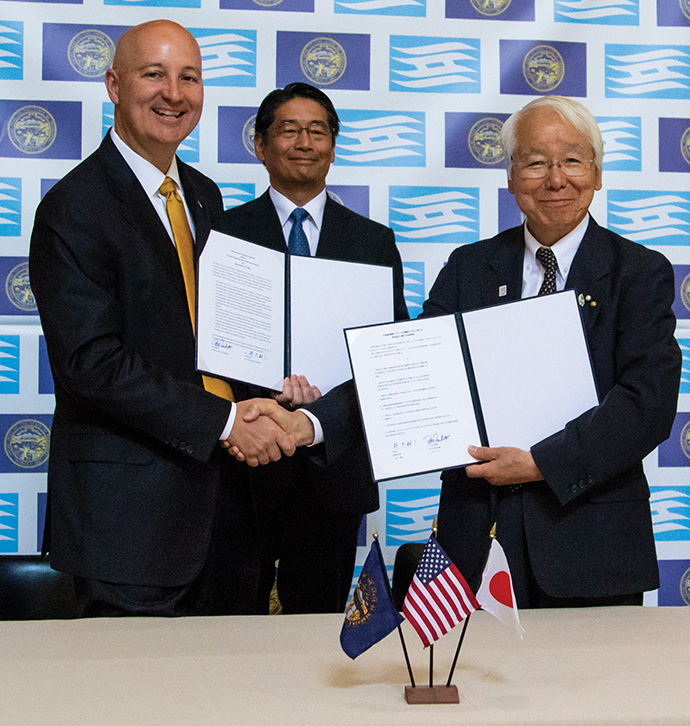
Those principles are paying off, the governor says, with Nebraska winning accolades from business publications in addition to Site Selection and other state-ranking entities for fiscal stability, low costs for businesses, favorable regulatory environment, workforce participation rate and wage growth. “We’ve created an environment that is conducive for people to invest and to know they can grow their company,” he says. “In this legislative session, we are continuing to reinforce those pillars, and we are expanding what we’re doing with regard to getting seventh and eighth graders involved in manufacturing and IT and building that pipeline from there through high school to post-secondary education. Regarding the latter, we’re expanding our scholarships around key areas like industrial technology, computer information systems, looking at what we can do with health care and engineering and math, but tailored for the institutions.”
Another focus is to streamline organizationally, perhaps by combining some agencies in order to better serve users.
2018 Top StatesBy Projects Per Capita |
|||
|---|---|---|---|
| 2018 | 2017 | STATE | PROJECTS |
| 1 | 1 | Nebraska | 118 |
| 2 | 2 | Kentucky | 228 |
| 3 | 3 | Ohio | 454 |
| 4 | 4 | Illinois | 444 |
| 5 | 6 | Iowa | 109 |
| 6 | 5 | Georgia | 300 |
| 7 | 18 | Virginia | 197 |
| 8 | 10 | Indiana | 144 |
| 9 | 21 | Nevada | 65 |
| 10 | 11 | Texas | 608 |
“The budget I proposed this year is only growing at 3.1 percent, and my agency operations are only growing at 2.3 percent,” says the governor. “Part of what we’re doing is taking the money where we’re controlling our spending and putting it into tax relief, increasing our property tax credit refund, for example, by 23 percent. And we’re proposing expanded tax cuts for military retirement benefits. We’re trying to be more competitive with regard to keeping our veterans in our state.”
Property Tax & Incentive Reform
Does the property tax issue Governor Ricketts has been tackling in recent years spill over to the corporate property arena? It does, he says, particularly with respect to commercial real estate.
“Last year we had a bill that got filibustered in our legislature — it was going to be a refundable tax credit based on property taxes,” he explains. “it was important to the business community that it wasn’t just for agriculture or residential, but that it also included commercial properties. That bill also had reducing our corporate income tax down to the level of our individual income tax in it. This year, one of the things we have to get done is revamping our Nebraska Advantage incentive system — not that I wouldn’t take the opportunity to try to reduce our income tax, but we’re really focusing on our incentives system to make it simpler, more transparent, easier to use and focused more on higher-wage jobs.”
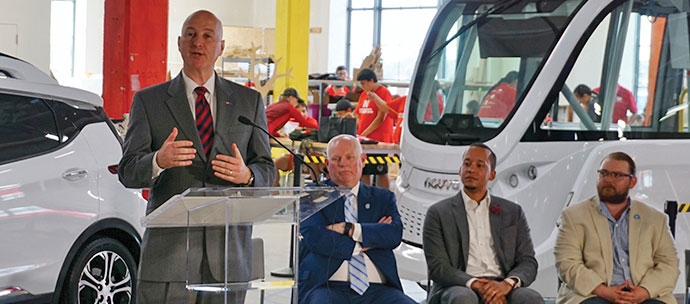
Something the governor hears from the business community is that the incentives system isn’t as easy to use as it could be, he says. It works on a per project basis, for instance, rather than on a per location basis. “That will help simplify the process — we want to make it easier on businesses and frankly easier on our revenue department to be able to manage it.
“We’re proposing expanded tax cuts for military retirement benefits. We’re trying to be more competitive with regard to keeping our veterans in our state.”
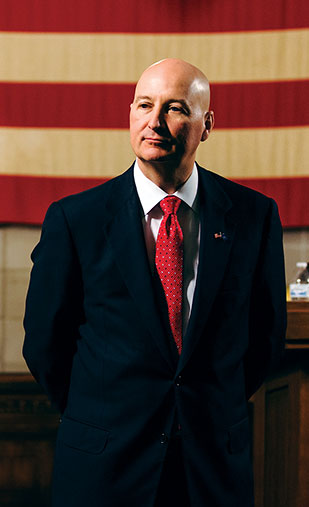
“The other aspect is focusing on higher-wage jobs,” says the governor. “That means targeting the areas that are going to help us. We have a limited amount of incentives, so we want to focus on the jobs that will pay higher wages and incent them to come to our state.”

Other measures include cultivating apprenticeship programs at companies and, as Governor Ricketts noted in his State of the State address, “recommending the creation of the Nebraska Talent Scholarships program to help our community colleges, state colleges, and the university system attract even more students in targeted programs from engineering to health care with over 2,100 new scholarships. Additionally,” he added, “I am recommending the expansion of the Developing Youth Talent Initiative to connect more middle school students to opportunities in manufacturing and IT with an additional $1.25 million annually. This program has already impacted 7,000 students, and this expansion will help reach even more. Working together to create more pathways, we can help connect more Nebraskans with the countless great opportunities available in communities statewide.”
Big or Small All Texas Projects Matter

In Texas, we continue to benefit from teamwork,” Governor Greg Abbott tells Site Selection. “This is not driven by the state alone. We have the very best local economic development teams in both urban and rural parts of the state. We have worked on expanding what we are doing in economic development beyond the cities and are focusing a lot on the rural areas. There have been a number of projects in smaller towns across Texas. We are working to spread the wealth to all regions of the state to make sure that all regions are benefiting in our economic development growth.”
Not to exclude any region, but by way of example, Abbott points to “a lot of activity in East Texas — in Mount Pleasant and Paris, in Lufkin and Temple — places people outside Texas wouldn’t be very familiar with. They’re communities of 100,000 people or less.” Just as with the enormous projects, like Apple’s $1-billion expansion in Austin and McKesson’s headquarters relocation to Irving, he notes, “the smaller projects in the smaller towns are just as important to them as the large projects are to our big cities.”
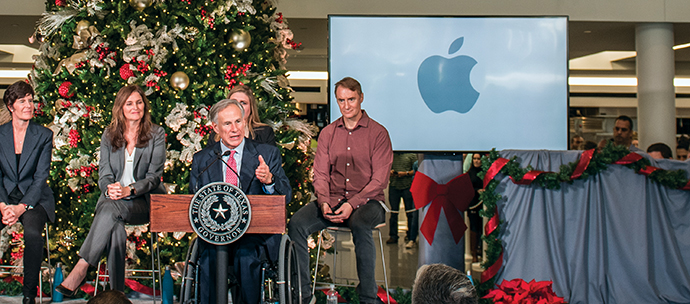
In December 2018, Apple announced a major expansion of its operations in Austin, including an investment of $1 billion to build a new campus in North Austin as well as new sites in Seattle, San Diego and Culver City and expansions in several other cities across the United States. Apple’s newest Austin campus will be located less than a mile from its existing facilities. The 133-acre (54-hectare) campus will initially accommodate 5,000 additional employees, with the capacity to grow to 15,000, and is expected to make Apple the largest private employer in Austin.
2018 Top StatesBy Number of Projects |
|||
|---|---|---|---|
| 2018 | 2017 | STATE | COUNT |
| 1 | 1 | Texas | 608 |
| 2 | 2 | Ohio | 454 |
| 3 | 3 | Illinois | 444 |
| 4 | 5 | Georgia | 300 |
| 5 | 7 | Kentucky | 228 |
| 6 | 4 | North Carolina | 217 |
| 7 | 10 | Virginia | 197 |
| 8 | 6 | California | 190 |
| 9 | 11 | Michigan | 171 |
| 10 | 13 | Florida | 151 |
“Apple is among the world’s most innovative companies and an avid creator of jobs in Texas and across the country,” said Texas Governor Greg Abbott at the expansion announcement. “Their decision to expand operations in our state is a testament to the high-quality workforce and unmatched economic environment that Texas offers. I thank Apple for this tremendous investment in Texas, and I look forward to building upon our strong partnership to create an even brighter future for the Lone Star State.” Jobs created at the new campus will include a broad range of functions including engineering, R&D, operations, finance, sales and customer support. At 6,200 people, Austin already represents the largest population of Apple employees outside Cupertino.
In November 2018, McKesson Corporation announced the relocation of its corporate headquarters from San Francisco to Las Colinas, Texas, effective April 1, 2019, expanding upon its presence in the Dallas area.
“We are excited to strengthen our presence in Texas and make Las Colinas our official global headquarters,” said John H. Hammergren, chairman and chief executive officer. “Governor Abbott and the Irving/Las Colinas community have provided tremendous support since we opened our Las Colinas campus last April. Making this move will improve efficiency, collaboration and cost-competitiveness, while providing an exceptional work environment for our employees.”
McKesson’s Las Colinas campus is already a key hub for the company. Employees at the North Texas location perform vital functions for the company in areas such as operations, information technology, finance and accounting, marketing and sales, administration and support, purchasing, and project management.
“Employers really do like hiring veterans, because they come with batteries included — they’re well trained and focused and they understand how to take instructions. It’s a matter of taking some of those who have committed their lives to our country and helping them to commit their future to a company.”
“I’m delighted McKesson, a Fortune 6 company, is making Texas the home of its new global headquarters,” said Governor Abbott. “The company has a long record of success in our state. McKesson’s expansion is an example of the kind of high-quality companies and jobs Texas has attracted as a result of our focus on economic growth, and I am proud to welcome them to the Lone Star State.”
Lawmakers Tackle Emergency Items
The Texas Legislature is in session, and “we’re off to a great start,” says the governor. “As great as Texas may be for business, if we succeed in everything that I’ve just made an emergency item, Texas will be far better. For example, our big push that we’re focused on already is a reduction in property taxes. Texas is a low tax state — no income tax. But property taxes are a burden. Our goal is to curtail that through property tax reform, because that’s good for businesses as well as for homeowners.
“Our other big push is on school finance reform and investing more in education, which will be very beneficial in advancing the workforce of the future. That includes more investment in higher education. That means the traditional four-year university program as well as two-year programs to make sure we’re providing the skilled workforce that our employers are demanding. We are keenly attuned to what the demands and needs are from our business partners in Texas and it’s a collaborative effort to make sure we will be the workforce that will fulfill their needs.”
The Lone Star State’s Texas Enterprise Fund (TEF) — a deal-closing fund — is a key factor in the state’s business recruitment strategy, and it now has a new feature. In June 2018, Governor Abbott announced an additional incentive program for new Texas Enterprise Fund (TEF) grantees designed to encourage the hiring of military veterans. New grantees, in addition to being eligible for funding on a per job created basis, will be eligible for an additional $1,000 per job filled by a veteran during the first year of job creation.
“We are keenly attuned to what the demands and needs are from our business partners in Texas.”

“Texas has one of the largest veteran populations of any state, and it is imperative that we ensure those returning from service continue to have opportunities to work and provide for their families,” said Governor Abbott. “Veterans bring unmatched leadership abilities and they already possess many of the technical skills employers are looking for. I’m proud of our state’s support for Texas veterans, and it’s my hope that future companies will take advantage of this program.”
Qualifying positions must be filled by a person who has served in the United States Army, Navy, Marine Corps, Air Force, or Coast Guard, the National or Air National Guard of the United States, the Texas Army National Guard, Texas Air National Guard, or served in a Reserve component of any of the aforementioned military organizations, and has been honorably discharged from the branch of the service in which the person served.
Last year, Governor Abbott unveiled a comprehensive plan to address the underemployment of Texas veterans, and committed to using all available resources to get the state’s veterans back to work after returning from service. “We find across the board that employers really do like hiring veterans, because they come with batteries included — they’re well trained and focused and they understand how to take instructions and follow orders,” the governor tells Site Selection. “It’s a matter of taking some of those who have committed their lives to our country and helping them to commit their future to a company.” Since its inception in 2004, the TEF has awarded about 160 grants totaling more than $615 million across a wide variety of industries and projects committed to creating almost 94,000 jobs and investing more than $27 billion in the state of Texas.
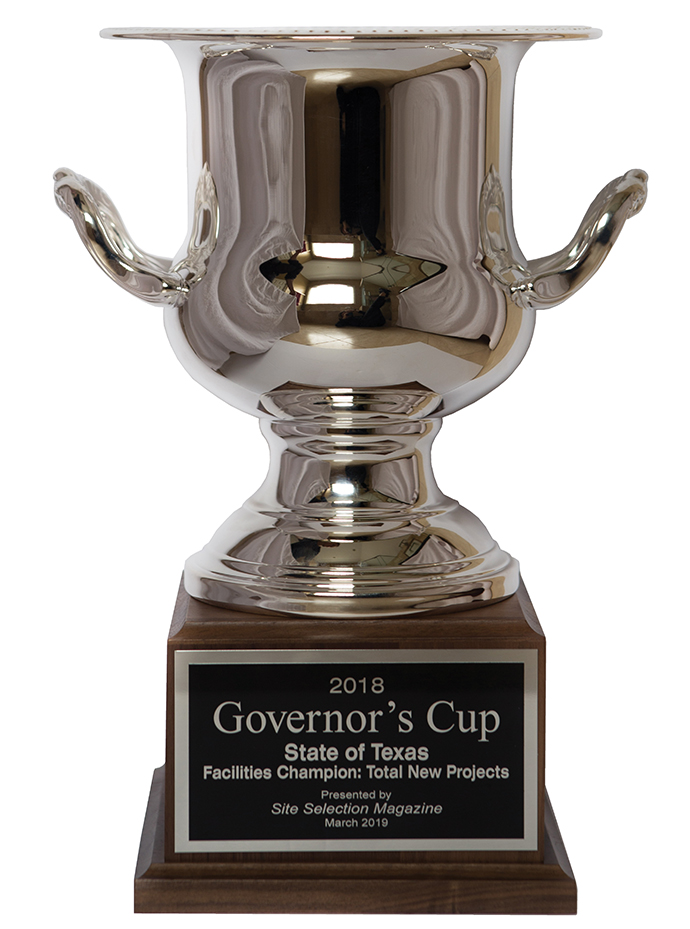
Governor Abbott also weighed in on trade agreements affecting his state, most notably the United States-Mexico-Canada Agreement. “I urge the Texas delegation to vote to pass it,” he relates. “The USMCA is great for Texas, which is the number one exporter in the country, and our number one trade partner is Mexico. Second is Canada. The USMCA is very important to the future of the Texas economy and to the future of the American economy. It is essential that Congress adopt and vote in favor of the USMCA.”
Now into his second term, Governor Abbott looks to the future. “We continue to excel in building out our infrastructure. We are continuing to add a little more than $7.5 billion a year to building out road infrastructure and making sure that Texas will provide for the infrastructure needs of our growing companies. And I can not emphasize enough our keen focus on developing the workforce that our employers are demanding.”

